
USS Comfort (AH-3) was a hospital ship for the United States Navy in World War I. She was the sister ship of USS Mercy (AH-4) but the two ships were not of a ship class. Comfort was known as SS Havana in passenger service for the Ward Line, and as USAT Havana in United States Army service before her Navy service. Her name was restored to Havana in 1927, and she was renamed SS Yucatán in 1935, and SS Agwileon in 1941. In World War II, she was known as USAT Agwileon and USAHS Shamrock in service for the United States Army.

USS Freedom (ID-3024) was a cargo and transport ship in the United States Navy during World War I. Originally SS Wittekind for the North German Lloyd line, the ship also served as USAT Iroquois and USAT Freedom after being seized by the United States in 1917.
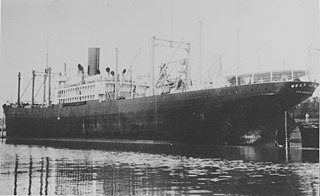
The USAT Meigs was a United States Army transport ship that was built in 1921 and sunk in Darwin Harbour in the first Japanese air raid against the Australia mainland on 19 February 1942.

USS General J. H. McRae (AP-149) was a General G. O. Squier-class transport ship built for the United States Maritime Commission during World War II. In 1946 she was transferred to the US Army and operated as USAT General J. H. McRae. On 1 March 1950 she was transferred to Military Sea Transportation Service and operated as USNS General J. H. McRae (T-AP-149). She was named for US Army Major General James H. McRae.
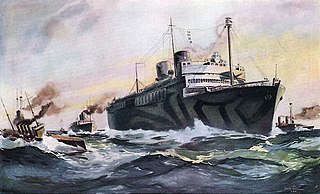
USS Siboney (ID-2999) was a United States Navy troopship in World War I. She was the sister ship of USS Orizaba (ID-1536). Launched as SS Oriente, she was soon renamed after Siboney, Cuba, a landing site of United States forces during the Spanish–American War. After her navy service ended, she was SS Siboney for the New York & Cuba Mail Steamship Co.. The ship was operated under charter by American Export Lines beginning in late 1940. During World War II she served the U.S. Army as transport USAT Siboney and as hospital ship USAHS Charles A. Stafford.

USS Bridgeport (AD-10/ID-3009) was a destroyer tender in the United States Navy during World War I and the years after. She was a twin-screw, steel-hulled passenger and cargo steamship built in 1901 at Vegesack, Germany as SS Breslau of the North German Lloyd line. Breslau was one of the seven ships of the Köln class of ships built for the Bremen to Baltimore and Galveston route.

USS Mercury (ID-3012) was a United States Navy transport ship during World War I. She was formerly the Norddeutscher Lloyd liner SS Barbarossa built by Blohm & Voss, Hamburg, Germany, in 1897, and operated by the North German Lloyd Line.

USS General M. L. Hersey (AP-148) was a General G. O. Squier-class transport ship of the U.S. Navy in World War II. She was named in honor of U.S. Army general Mark Leslie Hersey. She was transferred to the U.S. Army as USAT General M. L. Hersey in 1946. On 1 March 1950 she was transferred to the Military Sea Transportation Service (MSTS) as USNS General M. L. Hersey (T-AP-148). She was later sold for commercial use, and operated under the names SS Pittsburgh and SS St. Louis.
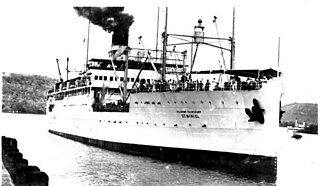
St. Mihiel was a troopship built for the United States Shipping Board by the American International Shipbuilding Corporation at Hog Island, Pennsylvania. The ship was operated from 1922 until mid-1940 as USAT St. Mihiel by the Army Transport Service. In July 1941 the ship was transferred to the Navy which commissioned her USS St. Mihiel with the hull number AP-32. In November 1943, she was transferred back to the Army and converted into the hospital ship, USAHS St. Mihiel.
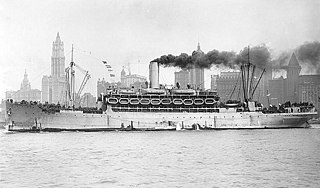
John L. Clem was built as the cargo and passenger liner Santa Ana for W. R. Grace and Company for service in Grace Line's South American service but was requisitioned before completion by the United States Shipping Board (USSB) in 1918 due to World War I. The ship was chartered back to Grace after completion until turned over to the United States Navy to be briefly commissioned as the troop transport USS Santa Ana (ID-2869) from 11 February 1919 to 21 July 1919.

USAT Thomas H. Barry, formerly SS Oriente, was a Ward Line ocean liner that became a United States Army troopship in the Second World War. She was intended for transfer to the United States Navy and assigned the hull number AP-45, but was not transferred and remained with the Army.

USS Matsonia (ID-1589) was a troopship used by the United States Navy during World War I. Before and after her Navy service she was ocean liner SS Matsonia for the Matson Navigation Company. The liner was sold in 1937 to the Alaska Packers Association and renamed SS Etolin. Shortly before World War II, the ship was chartered by the United States Army as USAT Etolin. Transferred to the War Shipping Administration in 1946, Etolin was placed in the James River Reserve Fleet and ultimately scrapped in 1957.
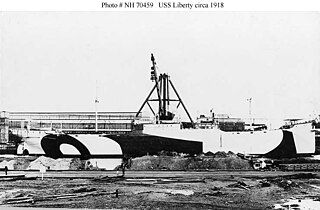
USAT Liberty was a United States Army cargo ship torpedoed by Japanese submarine I-166 in January 1942 and beached on the island of Bali, Indonesia. She had been built as a Design 1037 ship for the United States Shipping Board in World War I and had served in the United States Navy in that war as animal transport USS Liberty (ID-3461). She was also notable as the first ship constructed at Federal Shipbuilding, Kearny, New Jersey. In 1963 a volcanic eruption moved the ship off the beach, and Liberty's wreck is now a popular dive site.
USS Santa Cecilia (ID-4008) was the lead ship of her class of freighters of the United States Navy during World War I. In service for the United States Army she was known as USAT Santa Cecilia. Both before and after her World War I service she was known as SS Santa Cecilia for the Grace Line.
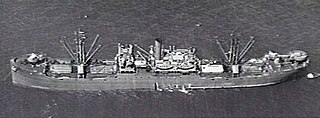
USS West Corum (ID-3982) was a cargo ship for the United States Navy in 1919. The ship was built as SS West Corum and reverted to that name at the end of her Navy service. During World War II, the ship was United States Army transport ship USAT West Corum, later renamed to Will H. Point.

USS General W. C. Gorgas (ID-1365) was a United States Navy troop transport in commission in 1919, named for William C. Gorgas. It was a German ship seized by the US Shipping Board after the US entered World War I. Under charter from 1917 from the Panama Railroad Company, it had carried troops and supplies to Europe. After being used as a troop transport to return troops from Europe in 1919, later that year it was converted back to commercial use as a passenger and freight ship operated by the Panama Railroad Company.

SS Edenton was a steel-hulled cargo ship built in 1918 for the United States Shipping Board as part of the Board's World War I emergency shipbuilding program.

USS West Elcasco (ID-3661) was a steel-hulled cargo ship which saw service as an auxiliary with the U.S. Navy in World War I and as an Army transport in World War II.

SS Barbara Olson was a cargo ship built in Wisconsin in 1918 as the SS Corrales. Barbara Olson was able to escape an attack off the coast of California in the early days of World War II. The Barbara Olson was built under a United States Shipping Board (USSB) contract in 1918 as the SS Corrales and renamed in 1940. On July 25, 1942, she was chartered by the US Army to transport supplies to the Territory of Hawaii as the USAT Barbara Olson for World War II. On January 14, 1946, her Army service ended. In 1964 she was run aground four miles (6.4 km) north of Pimentel, Peru and declared a total loss.


















